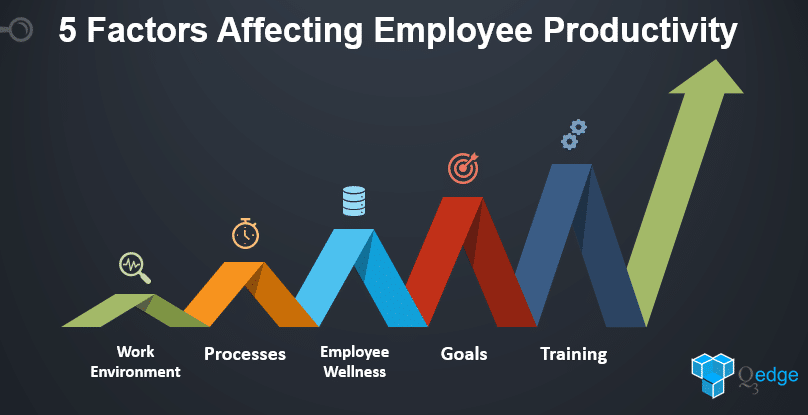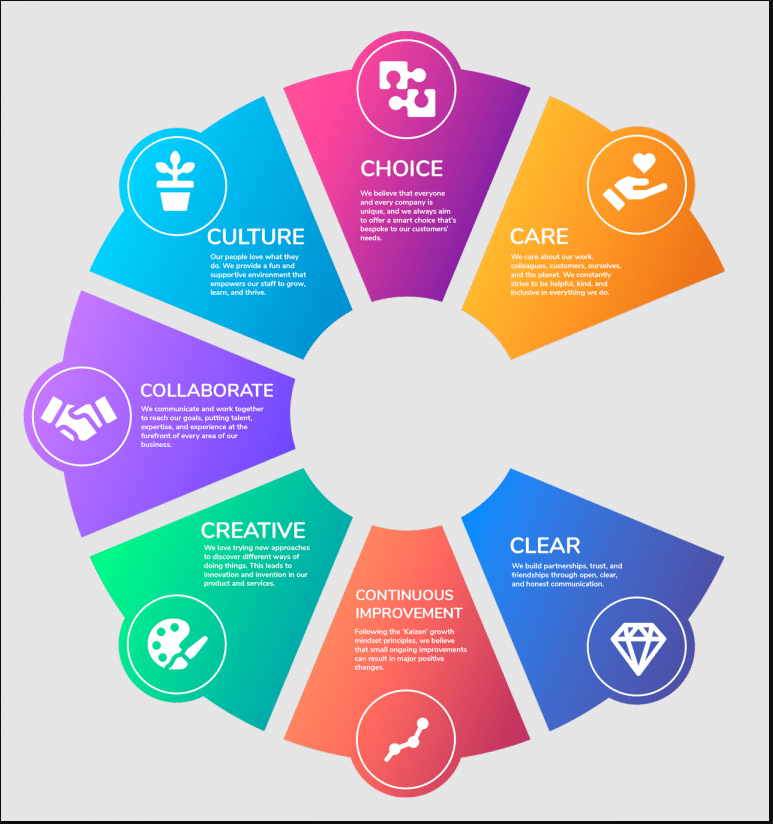
When discussing business performance, employee productivity often gets lost among the KPIs, ROIs, and all the other metrics we tend to obsess over. Unfortunately, this is a common manifestation of company leaders “missing the forest for the trees”.
Workforce efficiency is one of the most crucial cornerstones of your business’ success.
In this article, we’ll explain why that’s the case and introduce you to 10 ways to improve employee productivity. But first, we need to answer the important question of…
Why Is Employee Productivity Important?
Simply put, your employees’ performance is the basis for any success your company enjoys. People fuel daily operations, enabling long-term initiatives that directly affect nearly every aspect of your business. The higher employee productivity, the greater the effects.
Employee productivity influences:
- Increased ROI
- Better Customer Service
- Positive Workplace Culture
- Improved Audience Engagement
- Higher Employee Job Satisfaction
- and more…
Why Should You Improve Employee Productivity?
As you know, employee productivity describes how efficient your workers are with their time. Unfortunately, for most companies, this metric could also be defined with the words “not very efficient”.
Research suggests that the average office employee is only productive for around 2 hours and 53 minutes of their 8-hour workday (which translates to an efficiency of 31%). Most people tend to get distracted every 3 minutes, but it takes them approximately 23 minutes and 15 seconds to refocus. Consequently, only 6% of employees report feeling productive at work.
There are several factors to blame for this. Namely, they can be broken down into the following 4 categories:
-
- Work Environment – fear, anxiety, lack of recognition, and distractions are all guaranteed productivity killers in the workplace.
- Processes – convoluted and time-consuming processes are sure to frustrate anyone, no matter how good of a worker they are.
- Defined Goals – a lack of clear direction or leadership can cause employees to grasp in the dark.
- Employee Wellness – a happy employee is a productive employee, so it’s crucial that your worker’s needs and wants are met.
- Training – throwing someone off the deep end and expecting them to swim is a guaranteed recipe for disaster, so ensure everyone knows what, when, and how to do their job.

Source: Q3edge Consulting
We understand this information is enough to fill any manager’s heart with dread but don’t be alarmed. Take a moment to consider your company’s performance and think about just how much better it can be once you incorporate the following 10 tips for improving employee efficiency.
10 Effective Tips for Improving Employee Productivity
So, the need for improving employee productivity is clear. But the question is, how should you do it? In the next section, we’ll give you a clear guide to meet your team members’ needs, enable them to do their best work, and, ultimately, ensure they spend their time well.
#1: Understand the Workload
In recent years, employee burnout has become a more frequently discussed issue. And for a good reason, as it is one of the main contributors to lower team productivity and workforce churn.
Often, managers have unrealistic expectations for their employees due to a lack of understanding of their responsibilities and the time required to complete them. Consequently, this can lead to assigning unfulfillable schedules, causing stress, frustration, and eventually burnout in the workforce. But how can you prevent this?
The first step is to get a good grasp of your employees’ daily and weekly tasks. Arrange meetings with team members to discuss their work processes and how long they take. Considering these insights will allow you to create better-optimized schedules, maximizing your employees’ productivity in the long term without the risk of burnout.
#2: Improve Your Onboarding Process
Another common misconception is that onboarding new employees is a one-and-done thing. In reality, it takes a lot of time and effective leadership to properly integrate a person into an existing team without losing productivity.
You need to ensure new team members grasp what’s expected of them and how everything works. To that end, extensive training regarding tasks, work processes, and tools is necessary.
Furthermore, you need to be there for your latest hires in the first, most crucial, weeks and months of their tenure at your company, meaning you should schedule regular meetings and check-ins to make sure everything is going to plan.
When some of your new employees are working remotely, then onboarding can be a challenge. Some remote companies are hosting interactive onboarding webinars. By using some of the best webinar platforms, you can trigger interactions to your participants and get everyone engaged and on the same page. This would make onboarding fun and memorable.
#3: Focus on Values & Company Culture
Continuing from our previous point, another thing you need to instill in your employees for their long-term productivity and success is your company values and culture. This helps create loyalty, promotes pride in your team’s work, and encourages people to do their best.
But again, this isn’t as simple as it may seem at first glance. The process begins at the hiring stage, where you should look for potential hires that complement your existing workforce well and continue throughout their entire time at your company.

Source: Claromentis
#4: Create a Productive Work Environment
In a previous section, we discussed workplace distraction and how harmful it can be to employee productivity. Now, let’s see what we can do about it. But before we get started, we need to acknowledge the elephant in the room – the semi-recent rise of remote.
Naturally, you’ll have a much easier time tweaking the work conditions of your office workers as opposed to team members working from home. However, don’t make the false assumption that there’s nothing you can do for your remote employees. Here are a few recommendations for maximizing the productivity of each environment.
- Office: Ensure there’s enough natural light to prevent drowsiness. Include plenty of plant life around the office to create a relaxed environment. Avoid plain-white walls and surfaces and liven the place with splashes of color.
- Remote: Allow employees to set their work-related communications to “do-not-disturb” or “focus” modes. Encourage flexible work hours. Give workers access to work-specific devices to avoid unnecessary personal life distractions.
#5: Improve Communication
Being able to access information when and where you need it is a necessity for employee productivity. Your workers must be able to reach their co-workers, relevant stakeholders, and managers quickly and easily if you want them to do their best work.
And that’s where technology comes into play. Instead of limiting your workplace communications to email, an old and time-consuming solution, consider integrating a chat platform like Slack, Microsoft Teams, or otherwise.
These apps, compatible with most desktops, laptops, and mobile devices, encourage effective collaboration with one-on-one chats, dedicated channels, tagging features, and more.
Utilizing the best marketing agency client management software can greatly enhance the communication between the employee and team, thereby increasing the team productivity.
#6: Motivate Your Team
It should go without saying, but a motivated employee is productive. Unfortunately, there’s no one-stop solution to address everyone’s needs and desires. To that end, you’ll need to establish what motivates your staff and find the most efficient way to keep them engaged in the workplace and the work itself.
Raises, promotions, and performance bonuses are highly effective but not always viable options. However, even with a tighter budget, you don’t need to break the bank to motivate people. Simply listening to employees’ feedback, acknowledging their hard work, offering days off, flexible working hours, gym memberships, extra-curricular activities, or skill training can go a long way.
#7: Let People Work the Way That Suits Them Best
We’ve touched on remote work and flexible working hours in some previous sections, but they’re both topics worth exploring further. Stakeholder engagement strategies can also play a critical role in this discussion as it is important to ensure that all stakeholders are on board with the changes in work processes. The simple truth is that everyone has a different working process that allows them to produce the best results.
Throttling your employee’s individuality and trying to fit everyone into a single box is a one-way ticket to an unhappy work environment. So, if you genuinely want to boost employee productivity, allow your staff to work when and where it suits them best – within reason, of course.
#8: Optimize Work Processes
Living in our current technologically-powered age comes with its fair share of benefits. Employee productivity software and automation solutions litter the market as far as the eye can see. All you have to do is find the best tools to streamline your work processes and empower your workforce to do its best work.
Instead of having team members waste time on mind-numbing and repetitive manual labor, you can leave those tasks up to specialized tools and let your staff focus on what matters most. This will boost overall company efficiency and help engage people in their work and improve individual employee productivity to boot. For example, you can automate your financial processes with an invoicing tool that saves time and makes the work of your employees easier.
#9: Encourage Education
Another consequence of our fast-moving times is the constant changes in the work processes we experience. There are new tools and best practices seemingly every month, and if you want to keep up with your company’s success, you need to keep up.
And the key to doing that is ensuring your employees have access to resources to help them continuously grow and improve. Not only do skill courses boost your employees’ productivity and proficiency, but they can improve their work satisfaction. All in all, this simple investment is always a win-win for you.
#10: Give Your Employees Time to Rest
The final tip we’ll tackle in this article is obvious to some but nevertheless important. Holidays and vacations are a crucial part of a healthy work-life balance, so it’s a terrible shame they’re often underestimated.
If your staff works day-in-day-out for weeks or months, it’s sure to reflect in their productivity. You should keep a close eye on when your employees took their last break and encourage them to take some time off if it’s been a significant while.
This’ll help them return to work reenergized, with fresh eyes, and do better than before.
Conclusion
And there you have it, 10 tips to increase employee productivity, which you can start implementing right now! Although the process may be arduous, remember why you’re doing this – not only will these workplace tweaks help boost your staff’s satisfaction and efficiency, but also improve your business as a whole.
Looking For HR Management System?
Call Pursho @ 0731-6725516
Telegram Group One Must Follow :
For Startups: https://t.me/daily_business_reads







